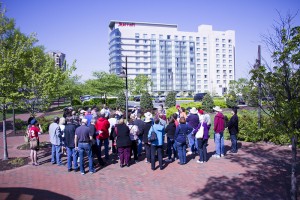Two days before the release of a request for developer’s ideas for Wheaton, Montgomery County Executive Isiah Leggett joined County Council President Nancy Navarro and others Saturday for a tour of the area where redevelopment has long been discussed.
“This is Wheaton’s time, and we’re going to do it, and we’re going to do it right,” Leggett said to the tour group including state and county officials as well as area residents.

The request for proposals, posted on the county’s website on Monday, asks for developers to come up with a plan that includes a headquarters building for the Maryland-National Capital Park and Planning Commission, a town square, residential and/or retail space, and public parking.
The plans can encompass up to four sites, including the Mid-County Regional Services Center, Parking Lot 13 and Parking Lot 34 in Wheaton and the current park and planning commission site at 8787 Georgia Avenue in Silver Spring.
Developers have until July 31 to submit their proposals.
As of Monday afternoon, the county website listed four companies who had downloaded a copy of the solicitation.
Leggett stressed to Saturday’s tour group that the redevelopment process will include community input and that the county wants Wheaton to be a community that “you are proud of.”
“This is not the end, this is simply the beginning, an opportunity for the public to weigh in, to be part of this process,” Leggett said. “Without the public’s involvement, whatever we do will not be successful.”
Navarro said that, for the first time, the county has money in the budget for Wheaton’s redevelopment and that the current approach will allow community members to participate.
“It allows all of you, all of those people who have been involved for so long, to see how we can maximize this opportunity,” Navarro said.
Saturday’s walking tour — run by the Coalition for Smarter Growth and the Wheaton Urban District Advisory Committee — highlighted several of Wheaton’s existing sites, including the MetroPointe apartments on Georgia Avenue — a mixed-income community — Wheaton Veterans Park, and the Wheaton Triangle area’s small businesses.
Henriot St. Gerard, chair of the urban district advisory committee, said a main goal of the event was to help people think about Wheaton in a broader sense than just the redevelopment of the Parking Lot 13 area and about its potential as a walkable community.
“It’s not just a focus on this centralized location in the urban district, we’re thinking about everyone outside of that,” including restaurants, entertainment venues and small businesses, St. Gerard said.
Speakers, including those from the coalition and the Wheaton advisory committee, discussed how the area could become more walkable through factors such as improved lighting, signage and pedestrian access.
Ash Kosiewicz — communications and advocacy director for the Latino Economic Development Center and lead organizer of the Coalition for the Fair Redevelopment of Wheaton — shared some of the concerns the area’s small businesses have voiced in light of redevelopment, including a loss of parking and their ability to pay rent.
With the release of the request for proposals, Marian Fryer — president of the Wheaton Citizens Coalition and member of the urban district advisory committee — said as she walked on the tour that there have been “many starts and stops” in Wheaton’s redevelopment process, but that she is now feeling optimistic.
That sense of optimism, she said, comes from “the fact that we now have an opportunity to get some good proposals, creative proposals, responsible development proposals and go from there and, hopefully, now that the money has been put in place, we won’t have to start over again.”
Del. Jeff Waldstreicher (D-Dist. 18) of Kensington, who attended the tour, compared the Wheaton area — where he said he grew up — to Silver Spring.
“People forget how many false starts there were in Silver Spring, and that’s okay,” Waldstreicher said. “There are going to be false starts and now Silver Spring is a great place to have dinner, raise a family, and the same thing will happen in Wheaton.”
For Andy Wexler, of Silver Spring, the tour was a source of information on the community he and his wife are considering moving to and have already visited for years to shop and eat.
“I hope that [redevelopment is] done very carefully,” he said. “There’s so many issues involved and if those issues aren’t dealt with in a very thoughtful and sensitive way, it can cause a lot of damage to a community.”
Photo courtesy of Greg Dohler and The Gazette








